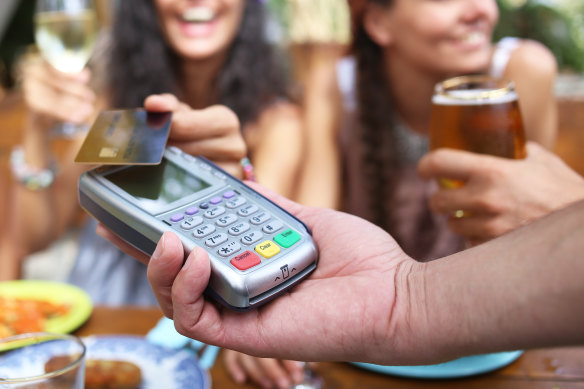- Analysis
- Money
- Banking
- Credit cards
More shoppers stung with card surcharges as cafes, pubs seek savings
By John Collett
More hospitality businesses are slapping customers who pay by card or via smartphone with a surcharge in a bid to offset some of their rapidly rising input costs due to high inflation.
Surcharging has always been most prevalent in the hospitality sector than others, but the number of pubs and bars, cafes, restaurants and fast food outlets with surcharges is rising as their profit margins come under pressure.

The hospitality sector has increased its use of card payment surcharges.Credit: iStock
Figures from payments provider Tyro shows that in May this year 40 per cent of cafes and restaurants levied surcharges, compared to 25 per cent in May 2022 when inflation started to rise. Meanwhile, 41 per cent of pubs and bars surcharged compared to 29 per cent a year earlier.
The figures from Tyro’s more than 66,000 business customers show that over the same period the portion of fast food businesses surcharging increased to 26 per cent from 16 per cent.
“Our data indicates that more merchants are looking to offset payment acceptance costs through surcharging, which may suggest that inflationary pressures have resulted in higher costs to run their businesses,” said Jon Davey, chief executive officer of Tyro Payments.
There are rules concerning what surcharges businesses can levy, which are overseen by the Australian Competition and Consumer Commission (ACCC). Under the rules, a surcharge can only reflect the actual costs to the business of accepting payment by card.
The Reserve Bank of Australia estimates the average costs for Eftpos to be less than 0.5 per cent, Visa and Mastercard debit between 0.5 per cent and 1 per cent, and Visa and Mastercard credit between 1 per cent and 1.5 per cent.
Some businesses charge a flat fee rather than a percentage surcharge. It is usually more expensive for the merchant to accept payment with premium awards credit cards and international cards.
The ACCC says the ban on excessive payment surcharges does not apply to BPAY, PayPal, Diners Club, American Express cards issued directly by American Express, or taxi fares.
If a business does not offer a way for customers to pay without incurring a surcharge, such as paying by cash, then the surcharge has to be clearly displayed. There is no legal requirement for merchants to accept cash for retail payments in Australia.
The ACCC says how much it costs a business to process a payment depends on the size, the technology used and the payment method. Small businesses usually have higher processing costs than large businesses.
Whatever the surcharge amount, the business must be able to prove the costs they have used to calculate it.
Ben Zyl, chief executive and co-founder of Waave, a start-up payments provider, says it’s “commonplace” to see card payment surcharges of 1.5 per cent, but some can be as high as 3 per cent.
“Some merchants aren’t clearly advising customers of a surcharge, either,” he says.
Zyl says that paying surcharges on daily purchases can quickly add up to a lot of wasted money on surcharges.
“Consumers should always ask if they are being surcharged and how much. If it seems excessive, raise that with the merchant or consider shopping elsewhere,” he says.
- Advice given in this article is general in nature and is not intended to influence readers’ decisions about investing or financial products. They should always seek their own professional advice that takes into account their own personal circumstances before making any financial decisions.
For expert tips on how to save, invest and make the most of your money, delivered to your inbox every Sunday, sign up for our Real Money newsletter here.